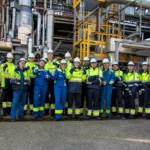Reducing natural gas costs must be central to the EU’s and Member States’ competitiveness. As the EU’s largest industrial consumer of natural gas (324 TWh, 2023) and electricity (149 TWh, 2023), the chemical industry faces an existential challenge from energy costs that far exceed those in other regions.
Over the past year, EU gas prices have been around four times higher than in the US. This not only drives up electricity prices but, with the EU increasingly reliant on LNG, embeds structurally higher costs into our energy markets. The result: site closures, reduced investment, and a growing risk of deindustrialisation across Europe.
Why is the chemical industry impacted by gas costs?
High gas prices hit the chemical industry in three ways: as a direct energy source, as feedstock, and as a price setter in electricity markets. For the chemical industry, natural gas is both a source of heat and a critical feedstock for processes. Substituting it is complex and costly, with limited alternatives available. While the industry continues to improve energy efficiency, these measures are not sufficient to solve the problem caused by ongoing, high energy costs.
While gas prices reflect market fundamentals, targeted policy measures are required to restore competitiveness and secure the future of Europe’s chemical industry.
How can EU policy lower the cost of gas?
Cefic’s position paper lays out four key actions.
- Utilise state aid frameworks for temporary relief on taxes and network tariffs:
Member States should use existing frameworks to provide short-term relief on electricity and gas taxes and network tariffs, coordinated across the EU to avoid market distortions. The ongoing revision of the Energy Taxation Directive must not increase the tax burden on natural gas, especially for operations with limited substitution options.
- Increase domestic gas supplies:
The EU should strengthen its energy security and reduce volatility by developing domestic natural gas resources and promoting renewable and low-carbon gases like biomethane. Dedicated support instruments and harmonised rules are needed to facilitate industrial uptake and cross-border trading.
- Reduce supply and planning uncertainty in gas markets:
The EU must improve regulatory clarity, particularly around methane emissions and long-term contracting. This includes realistic scenario setting, medium- to long-term demand forecasts, and streamlined compliance pathways for imports.
- Diversify gas supply:
Decision makers should continue to promote diversification of EU gas supplies, including LNG, and accelerate the rollout of robust certification systems for renewable and low-carbon gases. Joint purchasing should remain voluntary and market-based, with legal barriers removed where appropriate.
Cefic stands ready to work with policymakers to deliver a stable, affordable, and diversified energy future for European industry.










